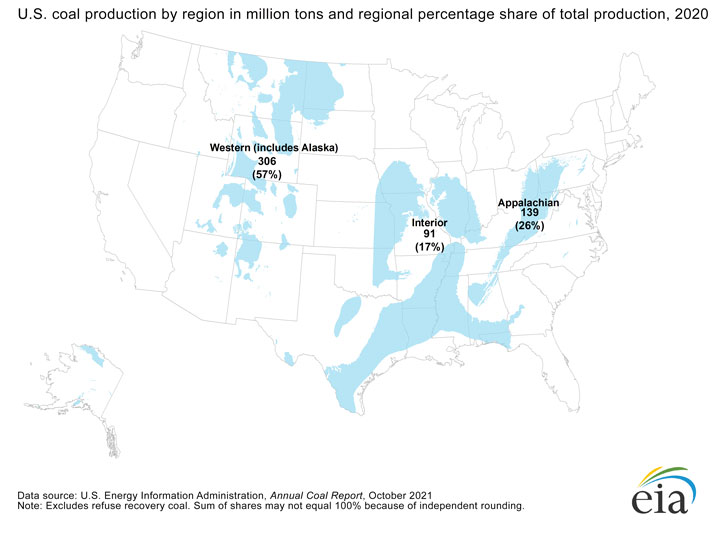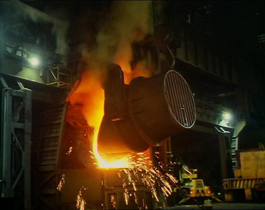Coal basics
Coal takes millions of years to form
Coal is a combustible black or brownish-black sedimentary rock with a high amount of carbon and hydrocarbons. Coal is classified as a nonrenewable energy source because it takes millions of years to form. Coal contains the energy stored by plants that lived hundreds of millions of years ago in swampy forests.
Layers of dirt and rock covered the plants over millions of years. The resulting pressure and heat turned the plants into the substance we call coal.
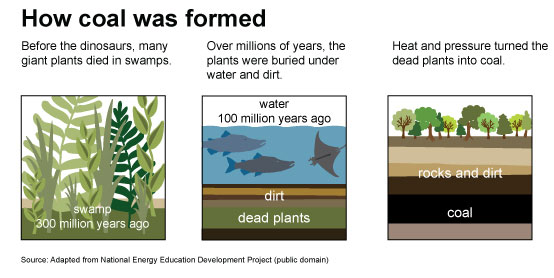
Types of coal
Coal is classified into four main types, or ranks: anthracite, bituminous, subbituminous, and lignite. The ranking depends on the types and amounts of carbon the coal contains and on the amount of heat energy the coal can produce. The rank of a coal deposit is determined by the amount of pressure and heat that acted on the plants over time.
Anthracite contains 86%–97% carbon and generally has the highest heating value of all ranks of coal. Anthracite accounted for less than 1% of the coal mined in the United States in 2020. All of the anthracite mines in the United States are in northeastern Pennsylvania. Anthracite is mainly used by the metals industry.
Bituminous coal contains 45%–86% carbon. Bituminous coal in the United States is between 100 million and 300 million years old. Bituminous coal is the most abundant rank of coal found in the United States, and it accounted for about 44% of total U.S. coal production in 2020. Bituminous coal is used to generate electricity and is an important fuel and raw material for making iron and steel. Bituminous coal was produced in at least 18 states in 2020, but five states accounted for about 74% of total bituminous production: West Virginia (28%), Pennsylvania (14%), Illinois (13%), Kentucky (10%), and Indiana (8%).
Subbituminous coal typically contains 35%–45% carbon, and it has a lower heating value than bituminous coal. Most subbituminous coal in the United States is at least 100 million years old. About 46% of total U.S. coal production in 2020 was subbituminous and about 88% was produced in Wyoming and 8% in Montana. The remainder was produced in Alaska, Colorado, and New Mexico.
Lignite contains 25%–35% carbon and has the lowest energy content of all coal ranks. Lignite coal deposits tend to be relatively young and were not subjected to extreme heat or pressure. Lignite is crumbly and has high moisture content, which contributes to its low heating value. Lignite accounted for 9% of total U.S. coal production in 2020. About 54% was mined in North Dakota and about 39% was mined in Texas. The other 7% was produced in Louisiana, Mississippi, and Montana. Lignite is mostly used to generate electricity. A facility in North Dakota also converts lignite to synthetic natural gas and pipes it to natural gas consumers in the eastern United States.
Mining and transporting coal
Mining coal
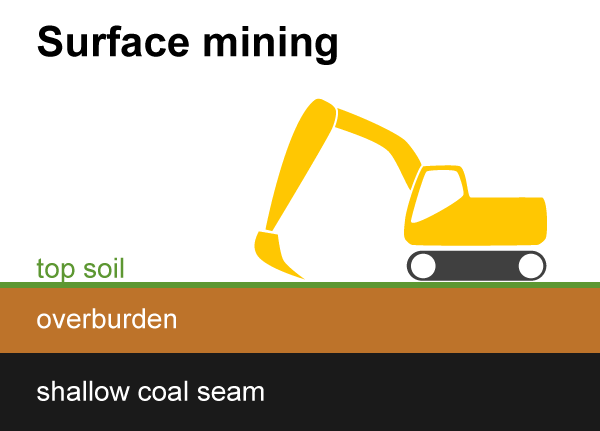
Source: Adapted from National Energy Education Development Project (public domain)
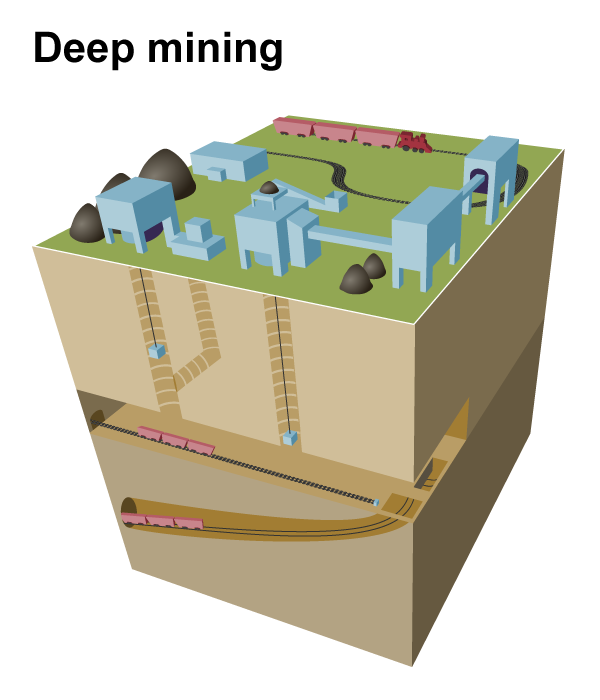
Source: Adapted from National Energy Education Development Project (public domain)
Coal miners use large machines to remove coal from the earth. Many U.S. coal deposits, called coal beds or seams, are near the earth's surface, while others are deep underground. Modern mining methods allow coal miners to easily reach most of the nation's coal reserves and to produce about three times more coal in one hour than in 1978.
Coal miners use two primary methods to remove coal
Surface mining is often used when coal is less than 200 feet underground. In surface mining, large machines remove the topsoil and layers of rock known as overburden to expose coal seams. Mountaintop removal is a form of surface mining where the tops of mountains are dynamited and removed to access coal seams. Once the coal is removed, the disturbed area may be covered with topsoil for planting grass and trees. About two-thirds of U.S. coal production is from surface mines because surface mining is less expensive than underground mining.
Underground mining, sometimes called deep mining, is necessary when the coal is several hundred feet below the surface. Some underground mines are thousands of feet deep with tunnels that may extend out from the vertical mine shafts for miles. Miners ride elevators down deep mine shafts and travel on small trains in long tunnels to get to the coal. The miners use large machines to dig out the coal.
Processing coal
After removing the coal from the ground, the miners may send it to a preparation plant near the mining site. The plant cleans and processes coal to remove rocks, dirt, ash, sulfur, and other unwanted materials. This process increases the heating value of the coal.
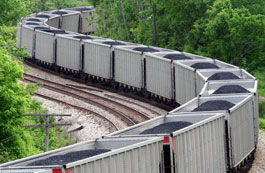
Source: Stock photography (copyrighted)
Transporting coal
Coal can be transported from mines and processing plants to consumers in several different ways:
- Conveyors, trams, and trucks move coal around mines, short distances from mines to consumers close to the mines, or to other modes of long-distance transportation.
- Trains transport nearly 70% of coal deliveries in the United States for at least part of the way from mines to consumers.
- Barges transport coal on rivers and lakes.
- Ships transport coal on the Great Lakes and the oceans to consumers in the United States and other countries.
- Slurry pipelines move mixtures of crushed coal and water. This method is not currently in use in the United States.
Transporting coal can be more expensive than the cost of mining coal. Some coal consumers, such as coal-fired electric power plants, are near coal mines to lower transportation costs.
Getting (producing) coal
Where the United States gets its coal
Did you know?
The two largest coal mines in the United States are the North Antelope Rochelle and Black Thunder mines in Wyoming. Together, the two mines produced 22% of total U.S. coal production in 2020. The North Antelope Rochelle mine alone produced nearly the same amount of coal in 2020 as the entire state of West Virginia, the second largest coal-producing state.
In 2020, about 535 million short tons of coal were produced in 22 U.S. states. Surface mines were the source of 63% of total U.S. coal production and accounted for 63% of the total number of coal mines. About 0.4 million tons, or about 0.1% of total coal production, was refuse recovery coal.
- Five states accounted for about 71% of total U.S. coal production in 2020:
- Wyoming41%
- West Virginia13%
- Pennsylvania7%
- Illinois6%
- North Dakota5%
Coal is mainly found in three regions: the Appalachian coal region, the Interior coal region, and the Western coal region (includes the Powder River Basin).
Facts and data for each coal-producing region for 2020
Appalachian coal region
- The Appalachian coal region includes Alabama, Eastern Kentucky, Maryland, Ohio, Pennsylvania, Tennessee, Virginia, and West Virginia.
- About 26% of the coal produced in the United States came from the Appalachian coal region.
- West Virginia is the largest coal-producing state in the region and the second-largest coal-producing state in the United States.
- Underground mines supplied 81% of the coal produced in the Appalachian region.
- Underground mines in the Appalachian region produced 58% of U.S. total underground coal mine production.
Interior coal region
- The Interior coal region includes Arkansas, Illinois, Indiana, Kansas, Louisiana, Mississippi, Missouri, Oklahoma, Texas, and Western Kentucky.
- About 17% of total U.S. coal was mined in the Interior coal region.
- Illinois was the largest coal producer in the Interior coal region, accounting for 35% of the region's coal production and 6% of total U.S. coal production.
- Underground mines supplied 60% of the region's coal production and surface mines supplied 40%.
Western coal region
- The Western coal region includes Alaska, Arizona, Colorado, Montana, New Mexico, North Dakota, Utah, Washington, and Wyoming.
- About 57% of total U.S. coal production was mined in the Western coal region.
- Wyoming, the largest coal-producing state in the United States, produced 41% of total U.S. coal production and 71% of the coal mined in the Western coal region.
- Eight of the top ten largest U.S. coal producing mines were in Wyoming, and all of those mines are surface mines.
- Surface mines produced 91% of the coal in the Western coal region.
Uses of coal
In 2021, about 546 million short tons (MMst) of coal were consumed in the United States. On an energy content basis, this amount was equal to about 10.5 quadrillion British thermal units (Btu) and to about 11% of total U.S. energy consumption. Although coal use was once common in the industrial, transportation, residential, and commercial sectors, today the main use of coal in the United States is to generate electricity. The electric power sector accounts for most of U.S. coal consumption. U.S. coal consumption peaked in 2007 and has declined in most years since then, mainly because of a decline in the use of coal for electricity generation.
U.S. coal consumption by consuming sector by amount—in million short tons—and percentage share of total coal consumption in 2021 was:
- Electric power—501.4 MMst—91.9%
- Industrial total—43.4 MMst—8.0%
- Industrial coke plants—17.6 MMst—3.2%
- Industrial combined heat and power—10.0 MMst—1.8%
- Other industrial—15.9 MMst—2.9%
- Commercial—0.8 MMst—1%
- Residential and transportation—each less than 1 MMst—less than 1%
Electric power
Power plants make steam by burning coal, and the steam turns turbines (machines for generating rotary mechanical power) to generate electricity.
Many industries and businesses have their own power plants, and some use coal to generate electricity, mostly in combined heat and power plants.
Industry
Many industries use coal and coal byproducts. The concrete and paper industries burn large amounts of coal to produce heat. The steel industry uses coal indirectly to make steel. Coal coke is made by baking coal in furnaces. The steel industry uses coal coke to smelt iron ore into iron to make steel. The high temperatures created by burning coal coke give steel the strength and flexibility needed for bridges, buildings, and automobiles.
Did you know?
A pound of coal supplies enough electricity to power ten 100-watt light bulbs for about an hour.
Converting coal into gas and liquids
Coal can be turned into gases and liquids that can be used as fuels or processed into chemicals to make other products. These gases or liquids are sometimes called synthetic fuels or synfuels. Synthetic fuels are made by heating coal in large vessels. These fuels produce fewer air pollutants when burned than burning coal directly.
In North Dakota, the Great Plains Synfuels Plant converts coal into synthetic natural gas (syngas). Syngas produced from coal can also be used to produce electricity and hydrogen. Currently, no commercially operating facilities in the United States produce liquids from coal, but coal has been converted to liquids in South Africa for decades.
Coal & the environment
Coal is an abundant fuel source that is relatively inexpensive to produce and convert to useful energy. However, producing and using coal affects the environment.
Effects of coal mining
Surface mines (sometimes called strip mines) were the source of about 62% of the coal mined in the United States in 2019. These mining operations remove the soil and rock above coal deposits, or seams. The largest surface mines in the United States are in Wyoming's Powder River Basin, where coal deposits are close to the surface and are up to 70 feet thick.
Mountaintop removal and valley fill mining has affected large areas of the Appalachian Mountains in West Virginia and Kentucky. In this form of coal extraction, the tops of mountains are removed using explosives. This technique changes the landscape, and streams are sometimes covered with rock and dirt. The water draining from these filled valleys may contain pollutants that can harm aquatic wildlife downstream. Although mountaintop mining has existed since the 1970s, its use became more widespread and controversial beginning in the 1990s.
U.S. laws require that dust and water runoff from areas affected by coal mining operations must be controlled, and the area must be reclaimed close to its original condition.
Did you know?
Some electric power plants use scrubbers (flue gas desulfurization equipment) to reduce the amount of sulfur exiting their smokestacks. The power plants use electrostatic precipitators or baghouses to remove particulates and heavy metals from the smoke.
Underground mines generally affect the landscape less than surface mines. However, the ground above mine tunnels can collapse, and acidic water can drain from abandoned underground mines.
Methane gas that occurs in coal deposits can explode if it concentrates in underground mines. This coalbed methane must be vented out of mines to make mines safer places to work. In 2020, methane emissions from coal mining and abandoned coal mines accounted for about 7% of total U.S. methane emissions and about 1% of total U.S. greenhouse gas emissions (based on global warming potential). Some mines capture and use or sell the coalbed methane extracted from mines.
Emissions from burning coal
Several principal emissions result from coal combustion:
- Sulfur dioxide (SO2), which contributes to acid rain and respiratory illnesses
- Nitrogen oxides (NOx), which contribute to smog and respiratory illnesses
- Particulates, which contribute to smog, haze, and respiratory illnesses and lung disease
- Carbon dioxide (CO2), which is the primary greenhouse gas produced from burning fossil fuels (coal, oil, and natural gas)
- Mercury and other heavy metals, which have been linked to both neurological and developmental damage in humans and other animals
- Fly ash and bottom ash, which are residues created when power plants burn coal
In the past, fly ash was released into the air through the smokestack, but laws now require that most emissions of fly ash be captured by pollution control devices. In the United States, fly ash and bottom ash are generally stored near power plants or placed in landfills. Pollution leaching from ash storage and landfills into groundwater and several large impoundments of ash that ruptured are environmental concerns.
Reducing the environmental effects of coal use
The Clean Air Act and The Clean Water Act require industries to reduce pollutants released into the air and water.
The coal industry has found several ways to reduce sulfur and other impurities from coal. The industry has also found more effective ways of cleaning coal after it is mined, and some coal consumers use low sulfur coal.
Power plants use flue gas desulfurization equipment, also known as scrubbers, to clean sulfur from the smoke before it leaves their smokestacks. In addition, the coal industry and the U.S. government have cooperated to develop technologies that can remove impurities from coal or that can make coal more energy efficient, which reduces the amount of coal that is burned per unit of useful energy produced.
Equipment intended mainly to reduce SO2, NOx, and particulate matter can also be used to reduce mercury emissions from some types of coal. Scientists are also working on new ways to reduce mercury emissions from coal-burning power plants.
Research is underway to address emissions of carbon dioxide from coal combustion. One method is carbon capture, which separates CO2 from emissions sources and recovers it in a concentrated stream. The CO2 can then be injected underground for permanent storage or (sequestration).
Reuse and recycling can also reduce the environmental effects of coal production and use. Land that was previously used for coal mining can be reclaimed and used for airports, landfills, and golf courses. Waste products captured by scrubbers can be used to produce products such as cement and synthetic gypsum for wallboard.


